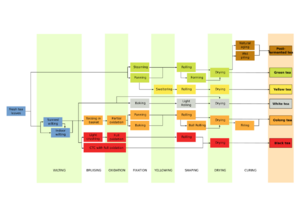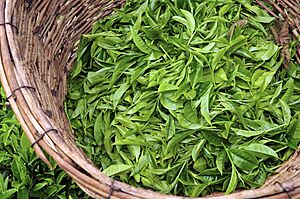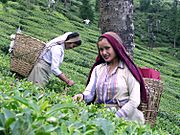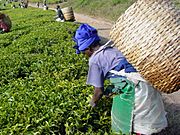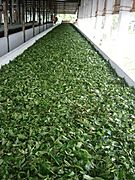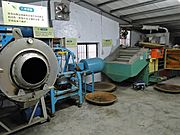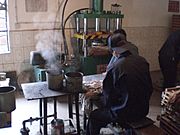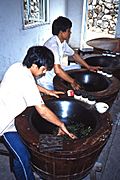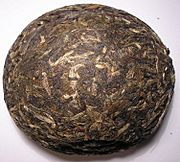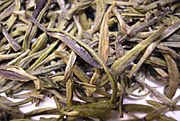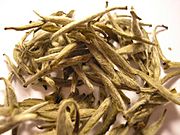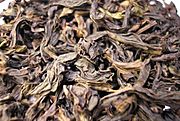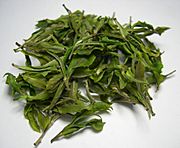Tea processing facts for kids
Tea processing is how fresh leaves from the tea plant (called Camellia sinensis) are turned into the dried leaves we use to make tea. The way tea leaves are processed changes their flavor, smell, and look. Different types of tea, like green tea or black tea, are made by using different processing steps.
The natural taste of dried tea leaves comes from the type of tea plant, how good the picked leaves are, and how they are processed. After processing, teas can be mixed with other teas or flavors to create new tastes. For black, pu-erh, and oolong teas, processing also helps them oxidize. This oxidation makes their flavors and smells even better.
Contents
History of Tea Processing
The story of how tea is processed is closely linked to how people in ancient China used and enjoyed tea. Tea plants were first grown and processed in areas like Southwest China, near what is now India and Myanmar, and Tibet. Many of these old processing ideas are still used today, but now machines do a lot of the work.
Early Green Tea
People in ancient China first found the tea plant in southeastern China. They used it as a medicine. The earliest way to process fresh tea leaves was to steam them right away and then dry them. This helped keep the leaves fresh. This method was perfected around the end of the Han Dynasty (about 206 BCE to 220 CE). It made a dried tea that is very much like today's green tea.
To use this dried tea, people would either boil it with water and other herbs, or grind it into a powder. Sometimes, the powder was mixed into a liquid, similar to how matcha is made today.
Later, as tea became more popular as a medicine, processing changed. Steamed tea leaves were not always dried right away. Instead, they were crushed into a paste. This paste was then pressed into molds and slowly dried to make tea bricks. A famous tea expert named Lu Yu wrote about this in his book The Classic of Tea. These tea bricks were easy to carry and store.
Yellow and Fermented Teas
Steaming tea leaves is a key step called "fixation." It stops the natural changes (oxidation) in the leaves. If the steaming wasn't controlled well in the past, or if the leaves weren't cooled quickly, they could turn yellow. This led to the creation of yellow tea. Even though green tea was popular, Lu Yu thought yellow tea tasted even better.
If steamed leaves were left in piles for too long before drying, tiny living things (microbes) would start to change them. This process is called microbial fermentation, and it creates post-fermented tea. This is similar to how compost is made, but it's carefully controlled. This method is still used for some teas, like Liu'an tea, and for ripe Pu-erh tea.
Storing tea in brick form for a long time also created another type of post-fermented tea. Over time, the tea bricks would change due to air, moisture, and microbes. This made the green tea bricks age and ferment. By the end of the Tang Dynasty (618–907 CE), green, yellow, and post-fermented teas were common in China. People started drinking tea for fun, not just for medicine.
Oolong and White Teas
Oolong tea was first made in the Fujian province during the Tang Dynasty. It was first made as thin bricks. A poet named Huang Furen wrote about how important it was to let the tea leaves wilt (dry slightly) under the sun and warm winds to make oolong tea. This showed that processing tea was not a simple job.
White tea was also developed in the Fujian province. It was first mentioned in a book from the Song Dynasty called Treatise on Tea. This book praised the delicate buds used for white tea, how hard it was to make, its taste, and how rare it was. A writer from the Ming Dynasty (1368–1644 CE) named Tian Yiheng described how Fuding white tea was made. He said that tea buds simply dried in the sun were better than those heated in a pan, because sun-dried tea tasted more natural and didn't have a smoky flavor.
Black Tea Development
The way to make black tea was first discovered in the late Ming Dynasty in Wuyishan, Fujian. It might have happened by accident, perhaps from over-oxidizing oolong tea leaves. In the early 1600s, tea makers in the Wuyi Mountains started to knead sun-withered tea leaves to break them up. Then, they let them dry in the sun, allowing them to fully oxidize. This created Gongfu black tea.
If there wasn't enough sun, the withered leaves were processed indoors in warm rooms. They were allowed to fully oxidize, then dried over pine fires. This created lapsang souchong. One story says that Lapsang Souchong was discovered when soldiers passed through a tea factory during the Ming Dynasty. This delayed the tea processing, causing the leaves to fully oxidize. The tea maker saved the leaves by drying them over a pine fire. By the Qing Dynasty (1644–1912 CE), both Lapsang Souchong and Gongfu black tea were well-known in China.
How Tea is Processed Today
Even though each type of tea tastes, smells, and looks different, the basic steps for processing all teas are quite similar. If tea is not handled carefully with the right moisture and temperature, mold can grow on it. This mold can spoil the tea and make it unsafe to drink.
- Plucking: Tea leaves and young shoots are picked from the Camellia sinensis bushes. This usually happens twice a year, in early spring and early summer. Picking is often done by hand for higher quality teas. Skilled pickers carefully pull the shoots using their fingers. Machines can also pick tea, but they might break more leaves, which can lower the tea's quality.
- Withering / Wilting: After picking, tea leaves start to wilt. This step removes extra water from the leaves and allows a tiny bit of oxidation to begin. Leaves can be placed in the sun or in a cool, airy room to dry out. In a special room, leaves are spread out for 8-14 hours, often overnight. During this time, they can lose a lot of their water. This process also helps break down proteins in the leaves, which changes the tea's taste.
- Disruption: This step is also called "leaf maceration." The tea leaves are gently bruised or torn. This helps speed up oxidation. Leaves can be shaken in bamboo trays or tumbled in baskets. More intense disruption involves kneading, rolling, tearing, and crushing, usually with machines. This breaking of the leaf cells allows enzymes to mix with other parts of the leaf, starting the oxidation process. It also releases some of the leaf juices, which adds to the tea's flavor.
- Oxidation: For teas that need oxidation, the leaves are left in a room with controlled temperature and humidity. They slowly turn darker. This is when the green color (chlorophyll) in the leaves breaks down, and other compounds called tannins are released or changed. The tea maker decides when to stop oxidation. This depends on the type of tea they want to make. Light oolong teas might be 5–40% oxidized, darker oolongs 60–70%, and black teas 100% oxidized. Oxidation is very important for creating many of the flavors and smells that give tea its color, strength, and fresh taste.
- Fixation / Kill-green: This step stops the tea leaf oxidation at the right level. It's done by heating the tea leaves gently. This turns off the enzymes that cause oxidation and removes any unwanted smells. Traditionally, leaves were heated in a wok or steamed. Today, machines might bake or "pan" them in a rolling drum. For some white teas and certain black teas, this step happens at the same time as drying.
- Sweltering / Yellowing: This step is only for yellow teas. After fixation, warm and damp tea leaves are put in a closed container and gently heated. This makes the green leaves turn yellow. The tea made from these leaves has a special yellowish-green color. This process changes the amino acids and other compounds in the leaves, giving yellow tea its unique fresh and smooth taste.
- Rolling / Shaping: The damp tea leaves are then rolled into wrinkled strips. This can be done by hand or with a rolling machine. These machines press the leaves between grooved plates, which tears, squeezes, and bruises them. This rolling also makes sap and oils ooze out, which improves the tea's flavor. The tea strips can then be shaped in other ways, like spirals, pellets, or even tied into balls or cones. For many oolong teas, the rolled leaves are put into cloth bags and kneaded by hand or machine to form spheres. Tea can also be pressed into bricks using heavy stones or presses.
- Drying: Drying finishes the tea so it's ready to sell. This can be done by panning, sunning, air drying, or baking. Baking is usually the most common method. It's important not to over-cook the leaves. Drying creates many new flavor compounds, especially important for green teas.
- Aging / Curing: Not all teas need this, but some teas get better with extra aging, fermentation, or baking. For example, a young green pu-erh tea might taste bitter. But after aging, it becomes sweet and smooth. Oolong tea can also taste better if it's aged after being fired over charcoal. Flavored teas are made at this stage by spraying them with aromas or storing them with other ingredients that give them flavor.
- Sorting: Sorting helps remove unwanted things like stems or seeds from the tea. Machines are often used to sort tea, especially black tea, to make the process more efficient. A color sorter can also be used to group teas by their color and shape, which helps classify their quality.
Quick facts for kids Pan-roasting Fixation |
|||||||||||
|---|---|---|---|---|---|---|---|---|---|---|---|

A Korean bhikkhuni pan roasting tea leaves for fixation
|
|||||||||||
| Chinese name | |||||||||||
| Traditional Chinese | 麩炒茶 | ||||||||||
|
|||||||||||
| Korean name | |||||||||||
| Hangul | 덖음차 / 부초차 | ||||||||||
| Hanja | --茶 / 麩炒茶 | ||||||||||
|
|||||||||||
| Steam Fixation | |||||||||||
|---|---|---|---|---|---|---|---|---|---|---|---|
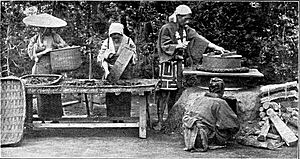
Steaming tea leaves for fixation
|
|||||||||||
| Chinese name | |||||||||||
| Traditional Chinese | 蒸製茶 | ||||||||||
|
|||||||||||
| Korean name | |||||||||||
| Hangul | 찐차 / 증제차 | ||||||||||
| Hanja | -茶 / 蒸製茶 | ||||||||||
|
|||||||||||
- Scenes of and equipment for tea processing
-
Tea plucking done by tea pickers at Puttabong Tea Estate, Darjeeling
-
Worker picking tea flushes in Tanzania.
-
Steaming and pressing pu-erh tea into tea bricks
Types of Tea by Processing
Tea is usually grouped by how much it has been oxidized or fermented:
- Examples of various types tea
-
Green Pu-erh tuo cha, a type of compressed raw pu-erh
-
Fuding Baihao Yinzhen, a white tea
-
Da Hong Pao, an Oolong tea
-
Organic Darjeeling White Tea processed at Arya Tea Estate in Darjeeling
-
Yunnan golden Dianhong, a Black tea


